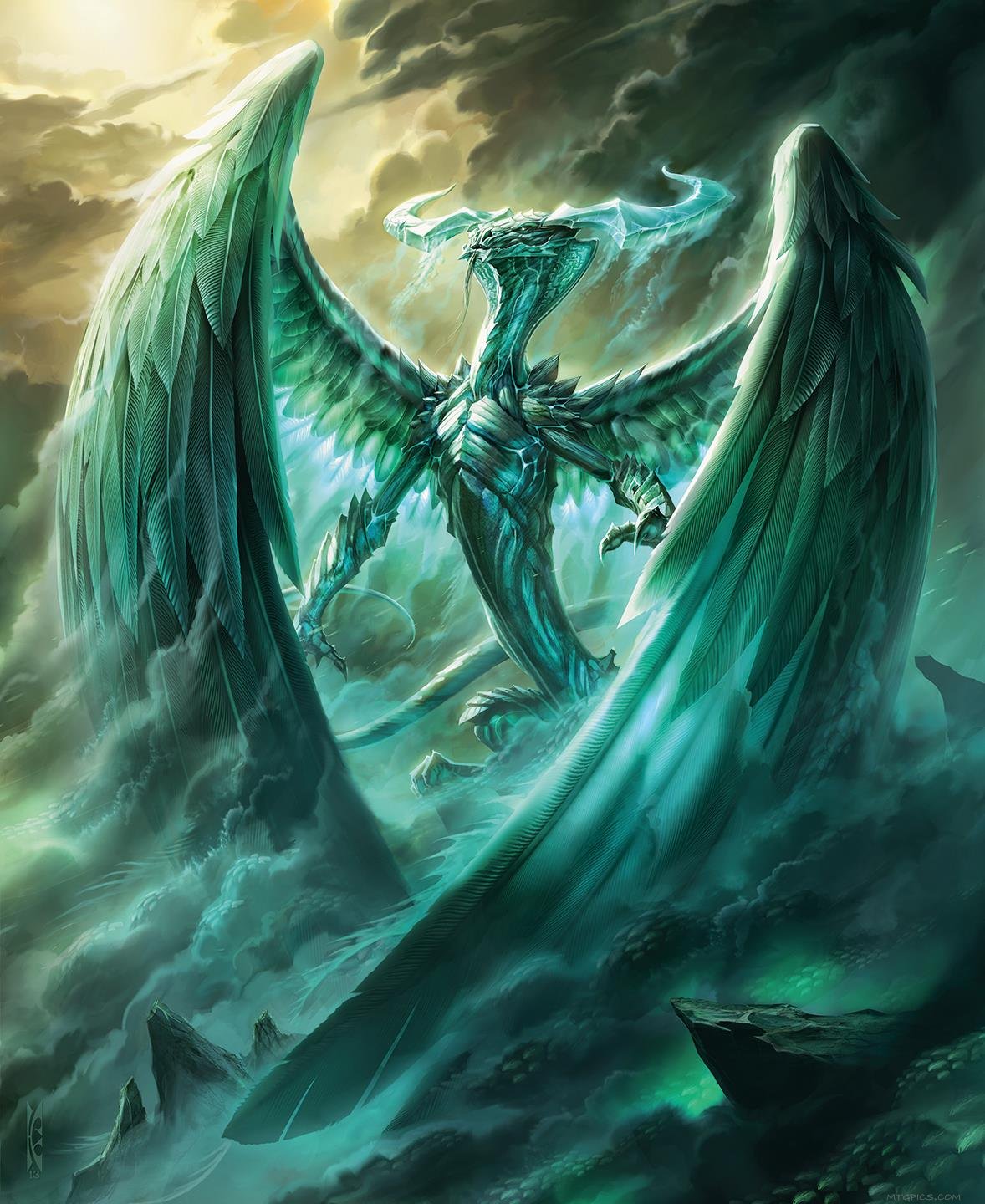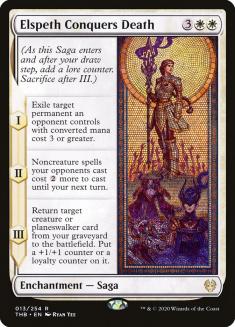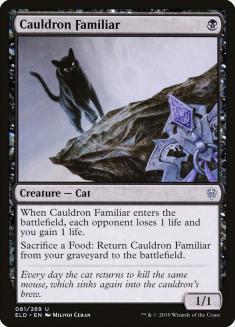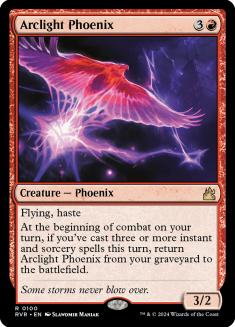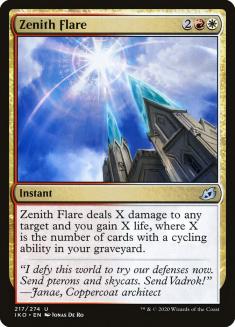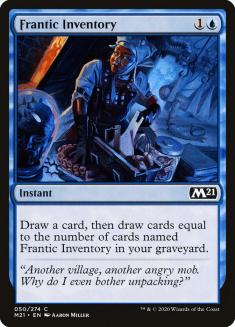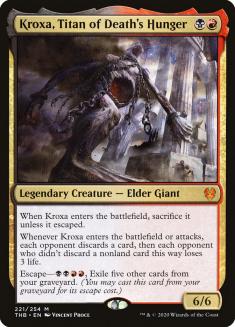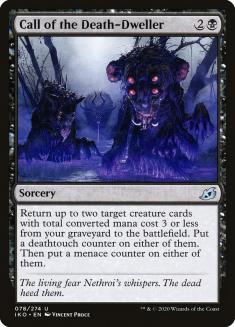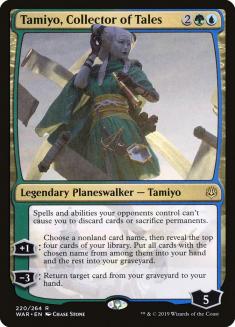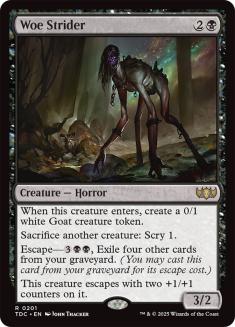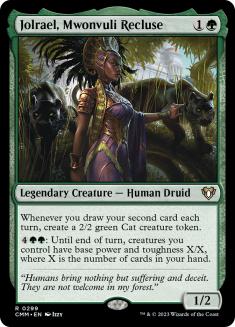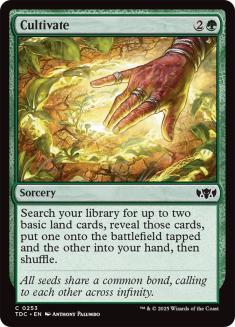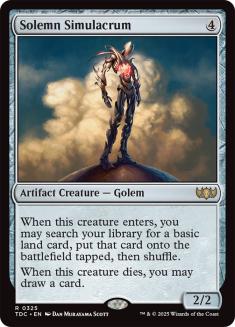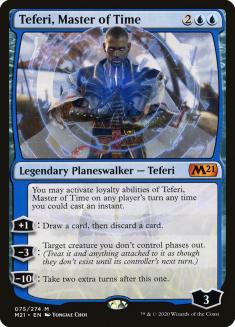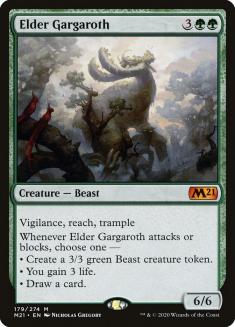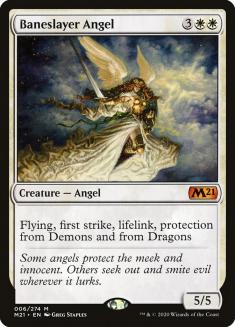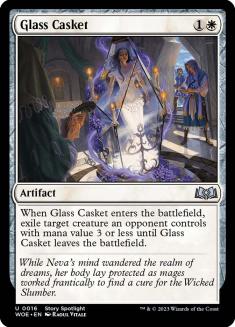Before the release of Core Set 2021, the top deck of Ikoria Standard was Temur Reclamation. Right after that followed Bant Control. Bant Control was normally understood to have a good (not great, but good) matchup versus Temur Reclamation, while struggling against some other choices, like Yorion Orzhov Control or Jund Sacrifice.
Temur Reclamation gained very little from Core Set 2021, but Bant Control potentially gained a lot, and some of these cards definitely look like they would help against its previously bad matchups. In today’s article, I’m going to go over the potential new choices from Core Set 2021 as well as the list I’ve been playing on Arena Ladder.
Originally, I was a bit skeptical of Scavenging Ooze in Bant Control — it is, after all, a card that operates on a somewhat different axis from what the deck is trying to do, which is to cast planeswalkers and ramp into powerful threats. After playing a little with it, all my doubts dissipated. Scavenging Ooze traditionally always ends up overperforming whenever it’s included in a deck, and its inclusion in Bant Control is no different.
The reason Scavenging Ooze is a good card even in a deck that theoretically wouldn’t want a random two-drop is that it fills many different roles in a single card, some of which simply couldn’t be filled before. Chief among those is graveyard hate, but in addition it is an early play that can block and pressure planeswalkers, it dominates combat later in the game, and it helps you stabilize by gaining life. Paying only two mana for all of these properties in a single card is a steal.
Many of the most powerful cards and interactions in Core Set 2021 Standard use the graveyard, and Scavenging Ooze lets you play an answer to these cards and interactions while not handicapping yourself versus the decks that don’t include them. Mono-Red Aggro, for example, doesn’t use the graveyard in any way, but it still doesn’t want to see a Scavenging Ooze on the other side of the battlefield if it can help it. This creates a scenario where Scavenging Ooze is either great or passable.
The most important graveyard interactions in Standard are the trifecta of Uro, Titan of Nature’s Wrath; Elspeth Conquers Death; and Cauldron Familiar.
Answering these cards will not automatically win you the game like they would against some graveyard strategies in other formats, but it does put a dent on the game plans of Temur Reclamation, Sultai Midrange, Bant Control, Yorion Orzhov Control, and Jund Sacrifice.
Past that, there are also a bunch of more fringe cards that get hit by Scavenging Ooze:
All in all, the card definitely does enough to earn a spot in Bant Control in my mind (as well as in several other decks).
Jolrael, Mwonvoli Recluse is another card that’s a bit unassuming and plays out better than it looks in Bant Control. A Turn 2 Jolrael against an aggro deck, especially if you’re on the play, could put an end to your opponent’s plans singlehandedly. Jolrael also pressures both players and planeswalkers more quickly than they’re used to from Bant Control builds, and its activated ability is much more powerful than it appears at first glance — it can easily kill an opponent out of nowhere.
There are several cards you can play in Bant Control that will trigger Jolrael — it curves naturally into Teferi, Time Raveler and Uro, Titan of Nature’s Wrath, and then also works with Growth Spiral, Shark Typhoon, and any potential Triomes that you play. It does require more tapping out on your turn than you’d normally want to do, so you cannot just throw it in a build with a million counterspells, but the more tap-out versions of the deck should be interesting.
Perhaps the biggest strength of Jolrael (and to a lesser extent Scavenging Ooze) is that it operates on a different angle from the rest of the deck, which puts other decks in a tough spot when it comes to mulliganing or sideboarding. For example, if I’m playing a Mono-Red deck, Shock is the first card I will put back in my library if I mulliganed, but now there are multiple problematic two-mana creatures I might need to deal with. Am I supposed to sideboard out Shock or keep it in?
What if I’m playing Azorius Control? Am I supposed to keep Glass Casket in my deck or in my opening hand? Should I sideboard in Heartless Act or Disfigure from my black deck, or Ram Through from Mono-Green Aggro? There is no good answer to those questions, and regardless of what your opponent does, they run the risk of having mismatched answers, which is really bad against a deck like Bant Control.
I’m honestly not as big a fan of Cultivate as most other people seem to be. Yeah, I get that it’s both acceleration and card advantage into one, and it makes sure you hit your land drops, but have you seen the ramp spells we’re working with in Core Set 2021 Standard? The reason the ramp cards are so good right now is that they have uses outside of just ramping — Growth Spiral draws a card later in the game; Nissa, Who Shakes the World pressures people and blocks; Uro, Titan of Nature’s Wrath does literally everything — yet Cultivate just ramps, and is a dead draw later in the game. You cannot even compare Cultivate with Uro, Titan of Nature’s Wrath, and there are only so many three-mana ramp spells you can play.
Another problem with Cultivate in a deck like Bant Control (as well as Temur Reclamation) is that you will be limited in the number of basic lands you play. Whenever I play Temur Reclamation, I often get into spots where I cannot even sacrifice Fabled Passage because I’ve run out of basics to get. With Cultivate, this problem is greatly exacerbated. If you thought topdecking Cultivate later in the game was bad, just wait until you topdeck it and don’t even have a basic left to find.
Solemn Simulacrum suffers from the same problems as Cultivate, but at least it does a little more. It blocks; draws a card; gets recurred by Elspeth Conquers Death; can be bounced back by Teferi, Time Raveler; survives Ugin activations; etc. Because of this, I’m more interested in Solemn Simulacrum than Cultivate, but I’m still not interested in Solemn Simulacrum because I don’t think you need a card like that when the options you have in Simic are just better. Besides, Bant Control benefits much more from ramping three mana into five mana instead of four into six.
If you don’t have access to the green ramp, however (e.g. Yorion Orzhov Control), I think this card is worth a closer look.
Ugin, the Spirit Dragon is another card that I underestimated. I played Ugin back when it was in Standard, but mostly as a one-of end-game trump. It did that very well, but it also rotted in your hand in half the games — you were paying a big cost by including an eight-drop in your deck.
Nowadays, it feels like hitting your eighth land drop is almost trivial. A deck like Bant Control is full of cantrips and acceleration, and honestly just full of lands. When you cast Ugin in Esper Dragons, it was your Turn 10 play to close out the game. When you cast Ugin in Bant Control, it’s a Turn 5 or Turn 6 play, and then it can become very oppressive. Add that to the fact that animated Nissa lands are immune to Ugin’s second ability (since they don’t have a color) and this two-card combo becomes quite powerful.
The biggest strength of Ugin in the Bant Control deck is that it offers you a card that goes over the top of everything, which you actually didn’t have before — it’s actually just your Expansion // Explosion. Obviously it’s not the same in a lot of matchups, as Expansion // Explosion can only be answered by counterspells and Ugin can be answered by Casualties of War, Elspeth Conquers Death, and Murderous Rider, but against matchups such as Jund Sacrifice, it offers a way to clear the battlefield and kill them before they can recover, all in one.
Teferi, Master of Time is still a big puzzle to me. It doesn’t seem good, but it plays out much better than it looks for the most part. Is that good enough? I’m not sure. It does a great job of fueling Uro or triggering Jolrael (and if you have Teferi out you can often trigger Jolrael on both turns), and sometimes it’s key for answering a haste creature or an Embercleave, but its minus ability is just not that great. If you need an instant-speed answer to a creature, it buys you a turn, but the creature won’t be on the battlefield on your turn, so you can’t deal with it with Shatter the Sky; Elspeth Conquers Death; or Teferi, Time Raveler, so you’re often just going to die to it the following turn anyway.
Still, it does enough, and is new enough, that I think it’s worth playing, at least to see where it lands. It wouldn’t surprise me if when all is said and done the correct number was zero. It also wouldn’t surprise me if it turns out to be very good and anyone who considered cutting it is crazy.
When Elder Gargaroth was previewed, I thought it was going to be the green Baneslayer Angel — not a card you played in the maindeck but a powerful sideboard option against aggressive decks, since not much beats a 6/6 in combat and it both attacks and blocks.
The reality, however, was that the card was not the same as Baneslayer Angel. Aggressive decks nowadays can actually just kill a 6/6 in combat, so you get some advantage with it but it doesn’t end the game the way Baneslayer seemed to. I experimented with two copies in the sideboard but I haven’t liked them.
Actual Baneslayer Angel, on the other hand, proved to be a much better card. The main reason for that is Embercleave. Embercleave will always kill Elder Gargaroth in combat, but it will not always kill Baneslayer Angel, and if it ever does kill it, it’ll be a trade. Questing Beast is another big reason to prefer Baneslayer.
You could argue that Dream Trawler is just a better Baneslayer Angel, and in many matchups that’s true, but as a sideboard card for aggro decks, Baneslayer is better, as it’s cheaper and a considerably better blocker. I’ve been happy with two Baneslayers in my sideboard.
This is the list I’ve been playing:
Creatures (10)
Planeswalkers (11)
- 2 Ugin, the Spirit Dragon
- 4 Teferi, Time Raveler
- 3 Nissa, Who Shakes the World
- 2 Teferi, Master of Time
Lands (28)
Spells (11)

This version is geared towards the emerging metagame that we have, where the new cards are naturally overrepresented. People are just trying out new stuff, and they don’t want to go and play an established deck with no new cards like Temur Reclamation.
Historically speaking, Bant Control has been good versus Temur Reclamation, but that was because it was built to beat it. This version is not, and therefore is quite weak to it, at least in Game 1. After sideboarding you get better tools, but the match is still unfavorable. If we get to a spot where Temur Reclamation is over 25% of the field again, you’d need to maindeck Dovin’s Veto and probably some Narsets. For now, I play mostly against ramp decks and creature decks, so I like the tap-out approach and the numerous copies of Shatter the Sky in this build.
Perhaps the most puzzling element of my list is only one copy of Shark Typhoon. To me, Shark Typhoon has two main functions. The first function is to act as a flash threat — something you can deploy without tapping out for on your turn. The second function is to kill pesky planeswalkers — Teferi, Time Raveler and Narset, Parter of Veils for the most part. The card is very versatile and does a lot of different things, such as blocking and putting a card in the graveyard for Uro, but the reason you include it in your deck is that you’re interested in at least of its two main functions, likely both.
In my mind, the current versions of Bant Control aren’t interested in either function. You don’t have many counterspells, so you’re not interested in playing the flash game, and because you don’t have counterspells, you don’t have this pressing need to kill Teferi. I’m still playing one because it’s a powerful card with applications at many points of the game, a mana sink for Nissa and so on, and because there’s nothing else I really want to play in that slot, but I don’t think it’s an essential card by any means.
The other puzzling element is Glass Casket in the sideboard. Even though it’s an artifact, Glass Casket isn’t colorless, and as such is a horrible nombo with Ugin, the Spirit Dragon, since you clear the battlefield only for them to immediately get a creature back and kill Ugin with it. Against some aggressive decks you’ll just take out Ugin when you bring in Glass Casket, but not always — sometimes the two cards will be in your deck together.
Honestly, I think Glass Casket is important enough that you just have to live with the anti-synergy. You could play the color hosers instead — Aether Gust and Devoted Decree — but then you need more slots (or you have fewer answers versus each particular deck that’s not Mono-Red), and even then there are some things that the hosers don’t answer. For example, there are some creature decks that are base white, so they dodge both Aether Gust and Devoted Decree, as does Stonecoil Serpent, which can otherwise be a problem for this deck. Your best bets here are to either target something that will not come back or will come back weakened (Stonecoil Serpent, Uro, Hydroid Krasis, a big Flourishing Fox); to bounce your Casket with Teferi before you cast Ugin; or to just hope that you can beat the one threat they have left in case you do need to use Ugin’s minus ability.
In the end, I think Core Set 2021 does a lot to shore up Bant Control’s weaknesses, to a point where I’m not scared to play it against anything with this list other than, ironically, Temur Reclamation. As it tends to go with control decks, you can build your list to beat one style of deck or the other, and right now I’m opting to build it to defeat the aggressive decks. Perhaps by the time the first big tournament comes up, this will be different and Temur Reclamation will have reclaimed its throne, but for the moment I feel comfortable where this is.

